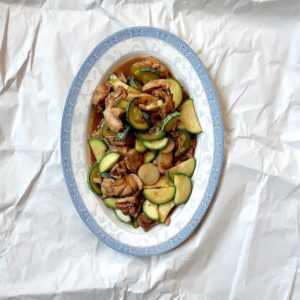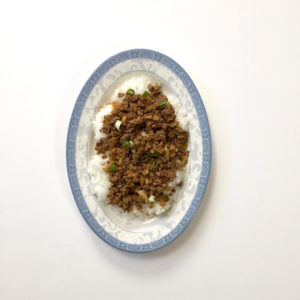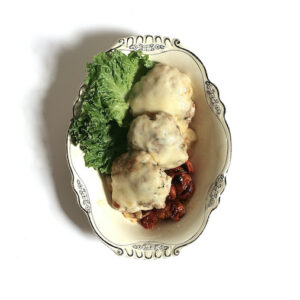Chicken with Water Chestnuts
When I was a child, we had a neighbor who was into what was then called “gourmet cooking.” Said neighbor also subscribed to Gourmet Magazine, which he shared with our household. This was during the Gail Zweigenthal years. I admit to finding the magazine dull, but I was a child–under age 10–with no interest in cooking. When it came to food, eating was the name of the game.

Yes, filler. But colorful filler.
I have no idea where this recipe comes from. Nor do I know its true name–not, I suspect, Chicken With Water Chestnuts. Sadly, the neighbor is no longer available to query. I was therefore reduced to recreating the dish from memory, in my insufficient kitchen.

Recreating dish from memory; i.e., screwing around with Pyrex.
In Gabrielle Hamilton’s Prune, the Toasted Manti recipe warns cooks not to “improve” it with the restaurant’s home-made pasta sheets or beef broth. I say the same to you here. Attempts to improve Chicken with Water Chestnuts with panko or butter or spring onions did not help matters. The most I’d suggest is the merest garlic clove and a squeeze of fresh lemon juice before serving.

Chicken with Water Chestnuts is one of those dishes that’s excellent as is. Leave it be.

A bit of what Nigella calls wittering:
We are not making fried chicken here. You want a light coating of seasoned flour, not a spackling.

Many chicken lovers, myself included, are very snooty about boneless skinless chicken breasts. All too often they’re tasteless, dry, and stringy–in a word, overcooked. Making matters worse, today’s boneless chicken breast seems to be gigantic, making it difficult to cook through without drying it out. I get around this by halving the breast, then giving it a gentle pounding with a meat mallet. If you lack a mallet, and are American, you might consider purchasing one. Remember, this is an election year. Meat mallets are a harmless way of destressing. The rest of you fortunate souls can use the bottom of a wine bottle, or a rolling pin. (Live in the UK? Buy a meat mallet.)

The canned water chestnut also comes in for much product snobbery by those in the know. Sample fresh water chestnuts and you, too, will join the snobfest. Alas, fresh water chestnuts come from China, and are scarce at the best of times. We are thus forced to rely on the canned chestnut. They come sliced or whole; use whichever you prefer.

All the water chestnut pix are crummy. We had artichokes with the chicken. The pictures are better, too.
The beer must be light: not low calorie, but a light wheat or IPA.
Ideally you want to serve your chicken with rice, so all that lovely beery sauce has something to saturate. You’ll notice there’s pasta in the photo, because your hostess, being an ace menu-planner, had served rice with dinner three days running prior to this meal. Oops.

Much as I try to offer dishes that hold well, chicken with water chestnuts is at its best fresh out of the oven. Leftovers will still be delicious, but the coating goes a bit soggy. Slice the chicken finely and fork it through any leftover rice, or make a sandwhich.

Chicken With Water Chestnuts
Yield: feeds 2-3; easily scaled upward
Preparation time: about one hour
Please read notes before cooking
1.5 pounds/680-700 grams boneless, skinless chicken breasts
1 large egg
generous 1/3 cup/45 grams all purpose flour
1 teaspoon dried oregano
1 teaspoon dried thyme
1 teaspoon salt
1 teaspoon white pepper, ideally, but black is fine
One 12 ounce/354 ml bottle light wheat or IPA beer
One 8 ounce/227gram can sliced or whole water chesnuts, drained and rinsed
olive oil, for the pan
A squeeze of fresh lemon juice
salt and pepper, to taste
Rice, to serve
Green salad, to serve
Crusty bread, to serve
Instructions
This recipe involves a great deal of handling raw chicken, so I’ll say this once. Be sure to wash all utensils, boards, bowls, and your hands with hot, soapy water. Spray counters with disinfectant agent. Change dishtowels/sponges frequently. Lecture concluded.
You will need two shallow bowls–pasta bowls are useful–and a large, shallow, heavy ovenproof pan to cook the chicken. I used my Staub “Everyday” pan, which is enamel over cast iron. It measures 14 inches/35cm across. A meat mallet is useful, but a rolling pin or empty wine bottle will work, too.
Preheat the oven to 350F/180C
Put the rice on to cook.
If your chicken pieces are large and thick, as mine were, halve them and flatten them lightly with a meat mallet or other heavy item. I do not cover my chicken with plastic wrap; I just tap carefully. I also keep the tenders. Set chicken aside.
In your first shallow bowl, break the egg and mix it lightly with a fork.
In the second shallow bowl, mix the flour, thyme, oregano, salt, and pepper.
Set your frying pan on the stove and pour in enough oil to generously coat the bottom–in my pan, this about two tablespoons. Turn the heat to medium. Allow the pan to heat for a minute or so.
Dip your chicken into the egg, then into the seasoned flour. See photo in blog post: you want a light coat, not a spackling.
Lay chicken in pan. Repeat until all pieces are in pan.
Allow chicken to cook 4-5 minutes, then turn it over. You want the coating to set, that’s all. The chicken won’t be cooked through.
Once you’ve cooked the chicken on both sides and it’s browned a bit, pour the beer over it. Tip in the water chestnuts. You might think it looks awful. Don’t worry.
Using potholders, carefully tuck the beery mess into the oven. Cook 20-30 minutes; checking at 20 minute mark. If you aren’t sure whether chicken is done, slice into a piece and look. There should be no pink and it should smell wonderful. Sneak a water chestnut.
Taste what is now the sauce: add a little lemon, salt and pepper if necessary.
Serve over rice and try not to scarf immediately. You only need a green salad with this, and bread is really fantastic with it. Really.
Notes:
As noted in the discussion, this is the rare recipe that does not benefit from “improvements.” You will have the best outcome using boneless, skinless chicken breast and following the recipe. If you can find fresh water chestnuts, feel free to use them, but canned truly taste fine here.
Use a light beer: I tested this recipe four times, and used a light wheat once and IPA’s three times to ensure the recipe worked.
Avoid panko. I tried it and it was all wrong here.
The original recipe used sliced water chestnuts, as do I. If you prefer whole ones, feel free.
In closing, I’d like to dedicate this post to the memory of Glenn Yasuda, who passed away on Valentine’s Day at age 85. Mr. Yasuda founded Berkeley Bowl, the grocery I speak of so often, and so very fondly, in many of my posts.
When I think of all the reasons to leave the Bay Area–the crowds, the rude drivers, the insane cost of living–I remember that I’d be leaving Berkeley Bowl. The world-famous produce. The dry goods aisle. The sustainable fish. The amazing wines. The sumptuous deli aisle. Foods from all over the world, sold to a clientele from all over the world. Walk through Berkeley Bowl on any given day and you’ll hear Mandarin, Spanish, English, Amharic, French, Erirtrean, Arabic.
And all thoughts of departure vanish.
Thank you, Mr. Yasuda. You will be missed.





